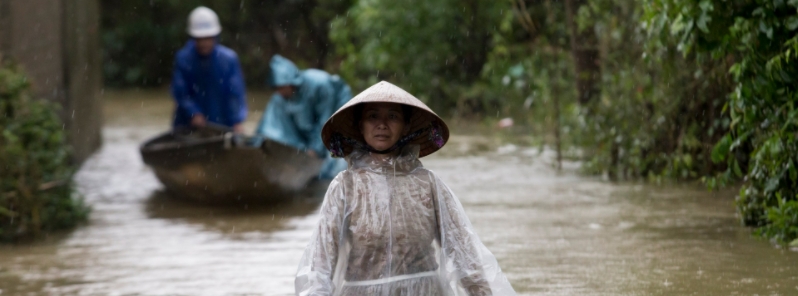Millions affected as Typhoon “Molave” hits central Vietnam – the country’s worst storm in 20 years

Typhoon "Molave" made landfall over Quang Nam and Quang Tri provinces in Vietnam's central region at 04:00 UTC (11:00 LT) on Wednesday, October 28, 2020, with maximum sustained winds of 165 km/h (103 mph) — a Category 2 hurricane equivalent. At least 2 people have been killed, 26 others are missing, and more than 1.7 million families were affected. The storm, which was described as the most powerful to hit Vietnam in the last 20 years, is worsening the current situation in the country as it is still suffering from major floods and landslides that took the lives of more than 150 people over the past weeks.
On Tuesday, October 27, winds of up to 135 km/h (84 mph) battered the area between Thua Thien-Hue and Phu Yen provinces. The region has recorded 250 mm (10 inches) of rainfall since the evening. Gia Lai in the Central Highlands was also hit by heavy rains and strong winds.
More than 1.7 million families have been affected by power outages, according to the Central Power Corporation.
The impacted provinces were Da Nang, Quang Tri, Thua Thien-Hue, Quang Nam, Quang Ngai, Binh Dinh, Phu Yen, Kon Tum, Gia Lai, and Dak Lak.
Hundreds of roofs were torn while several public works in Quang Ngai and Quang Nam were severely damaged. In Hoi An, many streets were inundated.
At least two fatalities have been reported by the Vietnam News Agency– both victims were killed by strong winds in separate incidents.
MEDIA RELEASE: Catastrophic floods across central Vietnam have already ruined the homes of more than 1 million people as yet another major storm takes aim for the battered region.
IFRC has launched an Emergency Appeal to fund relief and recovery efforts. https://t.co/jqr1RsdY0w pic.twitter.com/HzPWLsQeKA
— IFRC Asia Pacific (@IFRCAsiaPacific) October 28, 2020
VIDEO: A major typhoon is ripping off roofs and causing further destruction in #Vietnam as 1 million people already have homes in ruin from catastrophic floods over recent weeks. #TyphoonMolave #WithVietnam https://t.co/jqr1RsdY0w pic.twitter.com/SpXcroXyxN
— IFRC Asia Pacific (@IFRCAsiaPacific) October 28, 2020
Vietnam is evacuating over half a million people from its central coast ahead of Typhoon Molave, expected to be "one of the worst storms" in 20 years.
It is its 4th major storm this month, with over 130 people killed. Many areas are still flooded, with 178,000 homes inundated. pic.twitter.com/7g9tw88yIf
— AJ+ (@ajplus) October 28, 2020
Sad and frightening images are emerging from central Vietnam, which is being battered by typhoon Molave right now. Communities are in grave danger as they wait for this to pass.
pic.twitter.com/NXIibkiRL9— Blue Dragon (@BlueDragonVN) October 28, 2020
In Binh Dinh, 26 fishermen went missing after two fishing boats sank while they were trying to seek shelter. The government has mobilized almost 250 000 personnel and 2 300 vehicles for search and rescue operations.
"The people of Vietnam are tough, yet this is among the worst destruction ever seen in many areas," said Vietnam Red Cross Society president Nguyen Thi Xuan Thu.
"The relentless storms and flooding are taking a devastating human toll, further destroying livelihoods and isolating millions of people."
According to the National Center for Hydro-Meteorological Forecasting, Molave was the most powerful storm to hit Vietnam in the last 20 years, warning that it's especially dangerous due to its speed, size, and strength.


Central Vietnam is still reeling from weeks of major flooding and landslides due to severe weather, in which at least 150 people lost their lives.
More than 300 000 homes have been inundated, leaving nearly 1.2 million people in need of relief. Wide swaths of crops have been damaged, as well as bridges and several roads.
Molave is the fourth tropical cyclone to hit Vietnam this month alone.
As of 06:50 UTC on Wednesday, the storm is located about 200 km (125 miles) southeast of Da Nang, moving west-northwest at 25 km/h (16 mph), packing wind speeds of 130 km/h (81 mph) and maximum wind gusts of 185 km/h (115 mph), data from the Japan Meteorological Agency showed.
Prior to its landfall in Vietnam, Molave — known in the Philippines as Quinta — left at least nine people dead in the Philippines after it struck the nation on Monday, October 26.
Update
Molave left at least 13 people dead and 40 missing since it made landfall in Vietnam, authorities said Thursday, October 29.
Many settlements in Quang Nam province were destroyed by landslides, local media reported.
The death toll in the Philippines rose to 16, while four others remain missing, NDRRMC said Thursday.
More than 242 000 people were displaced in Luzon and the central Philippines. Extensive damage on crops and infrastructure was reported — estimated at over 737 million pesos (15.2 million USD). 105 roads and 22 bridges were damaged.
Featured image credit: IFRC Asia Pacific

Commenting rules and guidelines
We value the thoughts and opinions of our readers and welcome healthy discussions on our website. In order to maintain a respectful and positive community, we ask that all commenters follow these rules:
We reserve the right to remove any comments that violate these rules. By commenting on our website, you agree to abide by these guidelines. Thank you for helping to create a positive and welcoming environment for all.